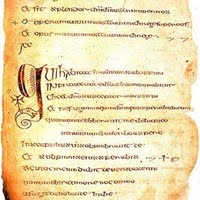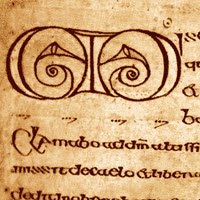Cathach of St. Columba
Medieval Psalter (St Colmcille), Irish
Illuminated Manuscript: History, Provenance.
![]()
![]()
|
Cathach of St. Columba |
 Cathach of St. Columba Royal Irish Academy, Dublin. Detail showing diminuendo. |
Cathach of St. ColumbaOne of the earliest Irish illuminated manuscripts, and a treasure of early Christian art, the Cathach of St. Columba (or the Cathach of Colmcille) was supposedly written by St Columba (who died in 597) during the sixth century CE and was associated with the Battle of Cúl Dreimhne (561). However, modern historical scholarship now dates it to the seventh century (c.610-620), thus ruling out any connection with St. Columba. The manuscript, a vellum Psalter, is both damaged and incomplete, and numbers 58 folios/pages (up to 200 X 130 mm in size) featuring the text of Psalms 30:10 to 105:13 in Vulgate Latin. Interpretative headings written in Old Irish appear above the text of the Psalms, making the Cathach the oldest surviving Irish manuscript written (in part) in gaelic, and the world's second oldest collection of Psalms. The psalter's name derives from the Irish Gaelic word "cath" meaning battle. "An Cathach" means the battler. (Note: For the world's oldest known illuminated Biblical text, see: the Garima Gospels (390-660) from Ethiopia.) |
 Cathach of St. Columba Detail showing decoration of Initial. |
|
ILLUSTRATED GOSPEL
TEXTS CELTIC CULTURES |
History Despite an imprecise provenance, the Cathach of St. Columba became an important relic and talisman used in battle by the Donegal Ó Domhnaill/ O'Donnell clan. Indeed, all of the Donegal clans it in high esteem. During the eleventh century, Cathbharr Ó Domhnaill, chief of the O'Donnells and Domhnall Mag Robhartaigh, the Abbot of Kells commissioned a special shrine (cumdach) for the Cathach. This comprised a 2-inch deep brass box some 9 inches by 8 inches. The lid, decorated with an image of the Crucifixion and an image of St Colmcille, was heavily ornamented with silver, crystals, pearls and other precious stones. |
|
CHRISTIAN CELTIC-STYLE
ART DESIGNS OF THE CELTS ART & ARCHITECTURE
IN IRELAND |
In 1691, this unique item of religious art was taken to France, returning only in 1802. It was rediscovered in 1813, when the cumdach was opened. Since 1842 the Cathach of St. Columba has resided at the Royal Irish Academy, while its shrine is on view at the National Museum of Ireland. Illuminations/Decorations of The Cathach of St. Columba The text is written in Irish half-uncials (uncials are capital letters, and the word 'uncial' comes from the Latin uncia, 'inch') and illuminated in a pure Celtic style. There are no pictures, or decorated borders: the decoration is purely calligraphic. Only the initial letter of each Psalm in the Cathach is decorated. These initials are inscribed in black ink and are larger than the main text. They are embellished with trumpet, spiral and guilloch patterns and outlined with red dots, a feature which gives the letters a rosy halo. Another typical embellishment is called diminuendo; a large capital letter is followed by a smaller one, and then a smaller one, and so on until the standard lower-case text-size is reached. This Celtic-style pattern-work may owe something to contemporary texts produced in Rome under Pope Gregory the Great, but in any event its motifs soon appear on nearly all forms of Irish Christian art, notably metalwork, Celtic high cross sculptures and illuminated ecclesiastical texts. Although the decorative detail is different from that used in later gospel manuscripts like the Book of Durrow and the Book of Kells - see for example Christ's Monogram Page - many of the Cathach's basic design concepts are repeated and greatly enhanced in later Insular illuminated gospel texts. |
|
LOOKING FOR ART
BOOKS? |
|
|
Codex Usserianus Primus The Cathach of St. Columba is not the oldest of all Irish manuscripts. This honour is believed to go to the slightly earlier Codex Usserianus Primus (also known as the Ussher Gospels, after James Ussher, Archbishop of Armagh), which was created in about 600-610, some years before the Cathach of St. Columba. If written entirely in Ireland, the Codex is the earliest example of an Insular artist replicating the Mediterranean style of decoration. Its decorative features are limited to linear and dot patterns in the colophons, indicating that the Celtic art of illumination had yet to acquire a distinct character of its own. The manuscript has a single remaining decoration, a cross outlined in black dots at the end of the Luke (folio 149v). Initials on folios 94, 101 and 107 are outlined by small red dots. This is the first appearance of this motif which was to become a regular feature of later Insular manuscripts. Legacy of The Cathach of St. Columba Despite its relatively primitive embellishments, The Cathach of St. Columba was the first Insular Christian manuscript in which graphic decoration began to assume a major role. In this sense it was the precursor to the glorious full-page illuminations of the Book of Kells, and the golden age of medieval visual arts in Ireland. |
|
• For more about the history of Irish
culture, see: Ireland Visual Arts. ENCYCLOPEDIA OF IRISH AND CELTIC ART |